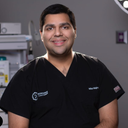This is a great question, as there are multiple options available for anesthesia during elective cosmetic procedures. What it boils down to, or should boil down to, is patient safety, comfort, and last: surgeon preference and comfort, which definitely plays some role.I was fortunate enough to do my cosmetics training with an incredibly wide breadth of surgeons in different cosmetic specialties within the core four: dermatologic surgery, oculoplastic surgery, facial plastic surgery, and plastic surgery. During that time, I did a large number of procedures under many different types of anesthesia, and developed my preferences from there.That being said, I prefer to do most of my cases with oral sedation and local anesthesia. This eliminates the need for general anesthesia, which often times is the most dangerous portion of the procedure, and it eliminates the long term cognitive issues with repeated bouts of general anesthesia. To boot, it allows the patient to return home immediately after the procedure to recover comfortably and safely there. There are no issues with blood pressure changes as there are after general anesthesia, which makes the postop recovery course less worrisome and less dangerous for getting a collection of blood, or hematoma.This type of anesthesia also completely eliminates the need for an anesthesiologist. From a financial standpoint, eliminating the need for an anesthesiologist makes the cost of the procedure last daunting.Again, you'll find multiple opinions and types of physicians doing the exact same procedure with different types of anesthesia, and this often boils down to surgeon comfort. Some surgeons just like their patients asleep. This tends to stem mostly from what their prior training was before cosmetics: someone who may have been a general surgeon or ENT and is now doing plastic surgery may prefer general anesthesia, as that is what they are comfortable with. I tend to find that the younger, more progressive and more recently trained surgeons are the ones most comfortable with local anesthetic procedures. It is interesting though, if you ask your surgeon who wants to put you under general anesthesia, it is likely that they use local anesthesia as well after you are under general already. Patients often ask, why? The answer to that is, it makes the dissection easier when you are doing a facelift or similar. I prefer to reserve general anesthesia only for when it's absolutely necessary necessary, which is not usually the case for an elective cosmetic procedure. This is not inappropriate, but general anesthesia should be justified by the procedure and safety, not surgeon comfort. To ensure you are receiving the highest level of care, seek out a dermatologic surgeon, oculoplastic surgeon, facial plastic surgeon or plastic surgeon who is board certified and fellowship trained in one of these "core four" cosmetic specialties.










